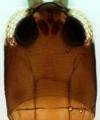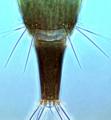Haplothrips robustus
Recognition data
Distinguishing features
Female fully winged. Body and legs dark brown, fore tarsi, apices of fore tibiae, and sometimes antennal segment III lighter; major setae on head and pronotum pale; fore wing pale with extreme base shaded. Head slightly longer than wide; maxillary stylets about one quarter of head width apart, retracted almost to eyes, maxillary bridge complete; postocular setae capitate. Antennae 8-segmented, segment III with 2 sensoria, IV with 4 sensoria; VIII broad at base. Pronotum with four pairs of capitate setae, midlateral setae no larger than discals; epimeral sutures complete; prosternal basantra and ferna present, mesopresternum eroded to paired lateral triangles. Fore tarsal tooth very small. Fore wing constricted medially, unusually broad distally, with no duplicated cilia; sub-basal setae capitate with bases forming a triangle. Tergites II–VIII with setae S1 capitate; tergite IX setae S1 and S2 bluntly rounded.
Male unknown.
Related and similar species
H. robustus is one of almost 20 species in this genus that lack duplicated cilia on the fore wing, and are therefore sometimes placed in a subgenus Trybomiella. The species is widespread in eastern Australia, and is known otherwise only from California. However, no males have ever been found, and it is similar in structure to a bisexual Afrotropical species, H. clarisetis Priesner (Mound & Minaei, 2007), under which name it was recorded originally from North America (O’Neill, 1960). The genus Haplothrips, one of the three most species rich genera of Thysanoptera, currently includes about 245 species worldwide (Mound & Minaei, 2007), these being found mainly from Europe across the Old World. No member of the genus is known to be endemic to the Neotropics, although a few species come from southern South America (Mound & Zapater, 2003), and only 17 species are listed from Mexico and North America (Mound & Marullo, 1996) with six of these recorded from California (Hoddle et al. 2004). Little is known of the biology of the Californian species, although elsewhere the species of Haplothrips are associated particularly with the flowers of Poaceae and Asteraceae.
Taxonomic data
Current valid name
Haplothrips robustus Bagnall
Original name and synonyms
- Haplothrips robustus Bagnall, 1918: 209
- Haplothrips melanoceratus Bagnall, 1918: 210
Family placement
Phlaeothripidae, Phlaeothripinae
Biological data
Life history
Presumably breeding in flowers.
Host plants
Adults taken from flowers of Asteraceae, Poaceae and Polygonaceae.
Tospoviruses vectored
None
Crop damage
Stated by O'Neill (1960) to be damaging lettuce, Lactuca sativa (Asteraceae) in New Mexico, but no details were provided concerning the type of damage.
Distribution data
Area of origin
Possibly Africa.
Distribution
Australia, New Mexico, California (Los Angeles and Riverside Counties)








